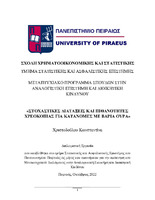| dc.contributor.advisor | Πολίτης, Κωνσταντίνος | |
| dc.contributor.author | Χριστοδούλου, Κωνσταντίνα | |
| dc.date.accessioned | 2022-11-21T11:20:02Z | |
| dc.date.available | 2022-11-21T11:20:02Z | |
| dc.date.issued | 2022-10 | |
| dc.identifier.uri | https://dione.lib.unipi.gr/xmlui/handle/unipi/14821 | |
| dc.identifier.uri | http://dx.doi.org/10.26267/unipi_dione/2243 | |
| dc.description.abstract | Τα μοντέλα της οικονομίας, της ιατρικής, και άλλων θετικών επιστημών εμπεριέχουν την αβεβαιότητα για να τονίσουν ότι δεν προβλέπονται όλες οι καταστάσεις και περιπτώσεις. Η αβεβαιότητα δεν είναι μετρήσιμη σε αντίθεση με τον κίνδυνο. Για παράδειγμα μπορεί να χαρακτηρίζεται από αβεβαιότητα ο επόμενος ισχυρός σεισμός που μπορεί να ισοπεδώσει δίκτυα μεταφορών και να οδηγήσει εκτός από απώλειες σε ανθρώπινες ζωές (το πιο σημαντικό), σε κατάρρευση τις οικονομίες που υπέστησαν το φυσικό φαινόμενο. Εντούτοις όμως, η μέτρηση της δυνητικά ισχυρού μεγέθους ζημιάς λόγω πιθανού γεγονότος μπορεί να μοντελοποιηθεί ως προς τι αναμένουμε και με ποια πιθανότητα. Εφόσον, ως εκ τούτου, πρόκειται για ισχυρά μεγέθη ζημιών, αναφερόμαστε σε κατανομές αυτών με βαριά δεξιά ουρά. Και τέλος, εφόσον οι κίνδυνοι διαφέρουν σε διάταξη μεταξύ τους, πόσο ένας μεγαλύτερος κίνδυνος επηρεάζει την πιθανότητα αυτή? Τα θέματα αυτά αναλύονται εκτενώς στην παρούσα διπλωματική. Αφού αρχικά, στο πρώτο Κεφάλαιο της εισαγωγής παρουσιάζουμε ιστορικά στοιχεία για την αναγκαιότητα αντιμετώπισης του ρίσκου, ακολούθως στο δεύτερο Κεφάλαιο παρουσιάζονται οι κατανομές με βαριά ουρά και συγκρίνονται μεταξύ τους ως προς τη βαρύτερη. Στο τρίτο Κεφάλαιο, παρουσιάζονται οι βασικές έννοιες των κλασσικών μοντέλων χρεοκοπίας σε συνεχή και διακριτό χρόνο και δίνεται έμφαση για την περίπτωση κατανομών βαριάς ουράς. Στο τέταρτο Κεφάλαιο, παρουσιάζονται οι κίνδυνοι (μεμονωμένοι ή χαρτοφυλάκια αυτών) βαριάς ουράς σε διάταξη όπως επίσης και οι διατάξεις της πιθανότητας χρεοκοπίας αυτών. Τέλος στο πέμπτο Κεφάλαιο αναπτύσσονται εφαρμογές των τριών ενοτήτων. | el |
| dc.format.extent | 118 | el |
| dc.language.iso | el | el |
| dc.publisher | Πανεπιστήμιο Πειραιώς | el |
| dc.rights | Αναφορά Δημιουργού-Μη Εμπορική Χρήση-Όχι Παράγωγα Έργα 3.0 Ελλάδα | * |
| dc.rights | Αναφορά Δημιουργού-Μη Εμπορική Χρήση-Όχι Παράγωγα Έργα 3.0 Ελλάδα | * |
| dc.rights.uri | http://creativecommons.org/licenses/by-nc-nd/3.0/gr/ | * |
| dc.title | Στοχαστικές διατάξεις και πιθανότητες χρεοκοπίας για κατανομές με βαριά ουρά | el |
| dc.title.alternative | Stochastic orders and ruin probabilities for heavy-tailed distributions | el |
| dc.type | Master Thesis | el |
| dc.contributor.department | Σχολή Χρηματοοικονομικής και Στατιστικής. Τμήμα Στατιστικής και Ασφαλιστικής Επιστήμης | el |
| dc.description.abstractEN | The mathematical models we use in economics, finance, insurance and other fields of applied science are stochastic, in order to incorporate the uncertainty inherent in them; that is, to emphasize that not all outcomes and cases are predicted. Unlike risk, uncertainty is not measurable. For example, the next strong earthquake can be characterized by uncertainty, which can affect transport networks and lead to the loss of human lives (most importantly), as well as the collapse of the economies that suffered the natural phenomenon. However, measuring the potentially strong amount of damage due to a potential event can be modeled in terms of what we expect and with what probability. Typically for such catastrophic risks the potential financial loss is represented by a heavy right-tailed distribution. Last but not least, since each and every risk differs from other in terms of structure, the following question may arise, "how much does a greater risk affect the foresaid probability". The above-mentioned issues are analyzed extensively throughout this dissertation. In the first introductory chapter, we present historical evidence for the necessity of facing risk itself. In the second chapter, the heavy-tailed distributions are presented and compared with each other in terms of the magnitude of their tail. In the third chapter, the basic concepts of classical models of ruin in continuous and discrete time are presented and emphasis is placed on the case of heavy tail distributions. In the fourth chapter, risk (individual or portfolio) of heavy-tailed distributions is presented, as well as the case of possible ruin. Finally, in the fifth chapter, implementation and illustration of the results in the previous three sections is carried out. | el |
| dc.contributor.master | Αναλογιστική Επιστήμη και Διοικητική Κινδύνου | el |
| dc.subject.keyword | Στοχαστικές διατάξεις | el |
| dc.subject.keyword | Βαριά ουρά | el |
| dc.subject.keyword | Θεωρία χρεοκοπίας | el |
| dc.date.defense | 2022-10-27 | |



